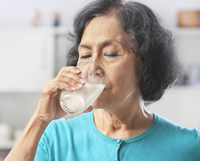|
 Planning for optimal bone health
Planning for optimal bone health
What’s wrong with this scenario?
For breakfast, Gladys the Calcium Queen devours a bowl of cold cereal and milk and then takes her 1,000 mg calcium supplement with a calcium-fortified cup of hot chocolate.
Answer:
Although bodies 50 years and younger require 1,000 mg of calcium per day, and individuals 51 and older need 1,200 mg of calcium per day, all human bodies can absorb only 500 mg of calcium at a time. While Gladys consumed approximately 1,500 mg of calcium during breakfast alone, 1,000 mgs will not be absorbed due to poor timing.
“By splitting up and spreading out calcium intake during the day, we can obtain optimum calcium absorption,” said Krista Lamoy, fragility fracture coordinator at Novant Health Charlotte Orthopedic Hospital. “It takes a little planning, but it makes all the difference.”
 Planning and lifelong healthy habits are key elements to optimal bone health and the highest quality of life. Unfortunately, when bones become weak and brittle, even mild stresses can cause debilitating fractures. Osteoporosis and low bone density affect 52 million Americans. By 2020, researchers anticipate more than half of Americans older than 50 will have osteoporosis. Planning and healthy habits can make a difference in those daunting statistics. Planning and lifelong healthy habits are key elements to optimal bone health and the highest quality of life. Unfortunately, when bones become weak and brittle, even mild stresses can cause debilitating fractures. Osteoporosis and low bone density affect 52 million Americans. By 2020, researchers anticipate more than half of Americans older than 50 will have osteoporosis. Planning and healthy habits can make a difference in those daunting statistics.
“Healthy habits involving weight-bearing exercises like walking, running, yoga, biking and lifting weights to strengthen bones and muscles, can slow bone loss,” said Lamoy. “It’s also vital to avoid unhealthy habits like smoking and excessive alcohol consumption.”
Diet can also impact bone density. Calcium is the most obvious focus, but don’t forget its gatekeeper, Vitamin D, which is essential for calcium absorption. Sunlight naturally emits Vitamin D, so soak up 15 to 20 minutes of rays without sunscreen each day. If skin cancer or high latitudes are a concern, consume Vitamin D-rich foods, such as egg yolks, sardines, liver or fish. Also, many calcium supplements come pre-paired with Vitamin D supplements.
Osteoporosis can affect anyone, but post-menopausal women have the greatest incidence of low bone density. Other factors include family history, frame size and race – white and Asian individuals tend to have the greatest risk. Small body frames experience elevated risks for osteoporosis because they have less bone mass to draw from as they age. Certain medications and nutrient-absorption issues also negatively impact bone health.
Because bone loss occurs slowly and quietly, without any outward signs or symptoms, it can go undetected until someone falls and breaks a bone — unless diagnostic testing is conducted in advance.
“No one can get low bone mass overnight. It develops over years, and people don’t know they have it unless they get tested for it,” said Lamoy.
Bone density mass can be measured by low levels of X-rays at local imaging centers. All post-menopausal women or women 65 years and older should be tested every two years. Younger women and men who have high risk factors should also be tested at 50 years old.
Learn more about osteoporosis prevention programs at Novant Health and take a risk assessment |

